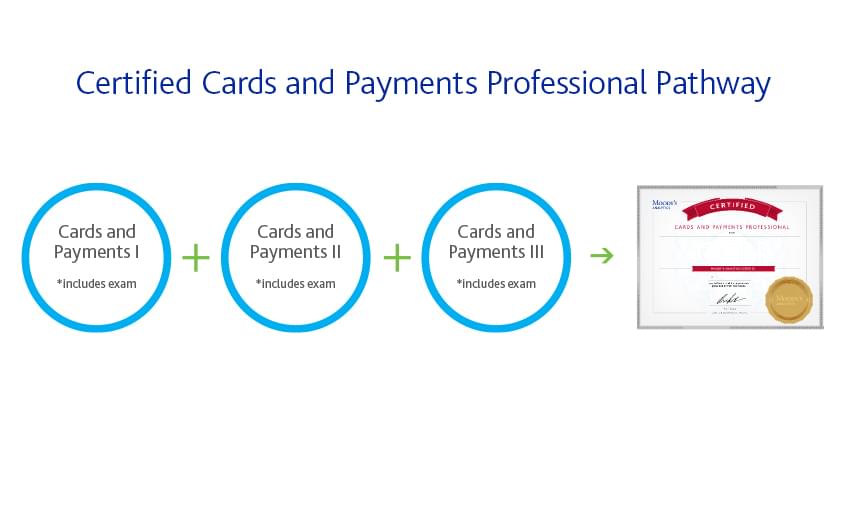Cards and Payments I
Register for the Course
What is Cards and Payments I?
The cards and payments business is unique owing to its specialized nature and dynamic technology-dependent operational rhythm. Individuals in this field require a broad understanding of the essential components and practices that define its business operations and products.
Cards and Payments I provides a broad overview and coverage of the entire lifecycle of all types of payments cards: credit cards, debit cards, prepaid cards, corporate cards, and mobile payments. You gain a comprehensive understanding of the operating environment, core technology requirements, risk management methodologies and various supporting services.
Upon completion, you have a deeper understanding of the cards and payments business models and product lifecycles. You acquire key tools and techniques that can be applied practically in your work environment.
Having successfully completed the CP I examination, you may use the ACP I designation after your name.
What will you learn by taking this course?
- Understand the core parameters, features, services, processes, management best practices and metrics that form the crux of a cards business
- Explain the key drivers of growth and risk
- Identify the decision areas of the cards business that define the operating environment
- Distinguish the unique features and concepts of Issuing and Acquiring in order to provide a comprehensive overview across the different aspects of the cards industry
With Moody’s Analytics eLearning:
- You take a flexible, convenient and scalable learning solution and align it to meet your organization’s strategic business and learning objectives
- You remain engaged in training, thanks to our interactive presentations and video content
- You elevate your professional currency by completing a course from a globally recognized leader in the retail banking space
- You develop skills you can immediately apply on the job, instantly enhancing your performance
Is there a pathway?
Continue your learning journey and progress your career by entering onto the next level of the Certified Cards and Payments Professional (CCPP) curriculum.
Cards and Payments II is the second level of the CCPP curriculum which focuses on the business acumen and competencies required to manage a profitable cards and payments business.

What is the exam structure?
-
- The Cards and Payments I examination has two parts, each lasting two hours. There is an eight-minute break between each part. Each part of the examination is conducted independently.
- The first part (Part A) comprises 80 multiple-choice questions. Each question has only one correct answer. Each question is worth one mark for a total of 80 marks.
- Questions in Part A examine for mastery of key principles and concepts from every Cards and Payments I module.
- The second part (Part B) has six scenarios. Each of these six scenarios require answers to eight multiple-choice questions.
- Each scenario is worth eight marks for a total of 48 marks.
- Questions in Part B examine for mastery of key principles and concepts presented in Retail Banking I.
- The use of calculators is permitted.
-
- The Cards and Payments II examination has two parts, each lasting two hours. There is an eight-minute break between each part. Each part of the examination is conducted independently.
- The first part (Part A) comprises 80 multiple-choice questions. Each question has only one correct answer. Each question is worth one mark for a total of 80 marks.
- Questions in Part A examine for mastery of key principles and concepts from every Cards and Payments II module.
- The second part (Part B) has six scenarios. Each of these six scenarios require answers to eight multiple-choice questions.
- Each scenario is worth eight marks for a total of 48 marks.
- The use of calculators is permitted.
-
- The Cards and Payments III examination has two parts, each lasting three hours. There is an eight-minute break between each part. Each part of the examination is conducted independently.
- The first part (Part A) has 24 multiple-choice questions and lasts for one hour. Each question is worth one mark for a total of 24 marks.
- Questions in Part A examine for mastery of advanced key principles and concepts from every Cards and Payments III module.
- The second part (Part B) comprises eight compulsory scenarios. Each scenario has a set of open questions that are worth a total of six marks each for a total of 48 marks.
- Questions in Part B examine for mastery of advanced principles and concepts from the Cards and Payments III curriculum. Participants will be examined on their abilities to demonstrate how the subject matter areas covered in the Cards and Payments III curriculum are connected.
- The use of calculators is permitted.
Criteria for Passing the CCPP Examinations
- The passing score is 55%.
- In calculating the final grade (Pass/Fail/Distinction) equal weighting is given to each part of the examination. A minimum score of 50% is required in each Part to pass the examination.







